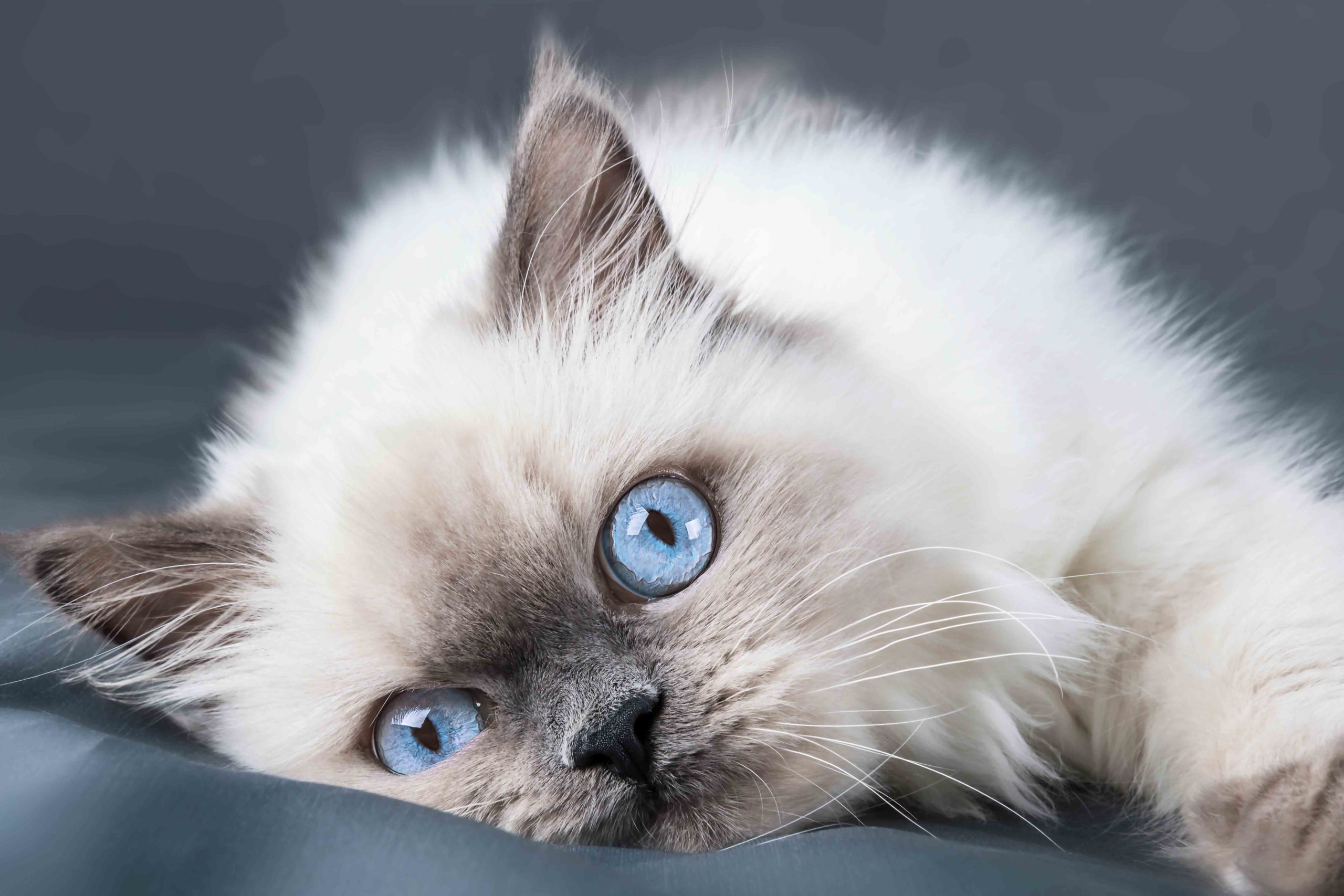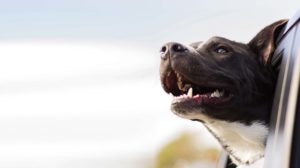Ragdoll cat | Breed highlights
| Breed: | Ragdolls are large, long-bodied pedigree cats. The breed is distinctive for its bright blue, oval-shaped eyes, and soft, fluffy coat. |
| Coat type: | Ragdolls have medium to long fur with textures ranging from silky and fine to thicker and dense. |
| Shedding: | Minimal shedding daily; however, Ragdolls shed extensively once a year (Spring). |
| Grooming: | Brush at least once weekly to prevent the fur from developing mats and tangles. |
| Activity level: | Moderate |
| Apartment friendly: | Yes |
| Small children: | Yes |
| Other pet friendly: | Yes |
What type of breed is a Ragdoll cat?
Ragdolls are large cats known for their relaxed natures, beauty and distinct colouring. The breed is affectionate, calm and less driven to hunt than other cat breeds. Ragdolls are unusual because they can ‘go limp’ when picked up. This physical quirk to become floppy when being carried earned them their name.
History of the Ragdoll cat
The Ragdoll was developed in the 1960s by US-based cat breeder Ann Baker. Breeding resulted from blending a white domestic long-haired female cat which resembled an Angora (a particular breed of long-haired cat) with other domestic cats. Baker’s breeding program through successive litters refined characteristics, traits and colourings.
The Ragdoll’s ability to thoroughly relax when carried – also known as the ‘Ragdoll flop’ – is associated with the breed’s docile personality. The origins of this trait are unclear; however, some claim it might be related to the sensation of being picked and carried as a kitten. While other cat breeds generally outgrow their need for this type of soothing, it seems the Ragdoll has retained this reflex into adulthood.
Ragdoll cat appearance and characteristics
Ragdolls are a large breed; males can top the scale at 10 kilograms. Females are generally smaller. Ragdolls are also a slow-maturing breed. They grow into their full coat colour when they are two years old and reach full size and body weight at 4 years.
All Ragdolls have blue eyes, and their coats are semi-long or long. The breed is known as a “pointed breed” which means their bodies are lighter in colour than the extremities, the face, legs, tail, and ears which are darker
Pointed variations include Seal Point, Blue Point, Flame Point (cream-coloured coat with reddish-orange points), Blue Mitted Ragdoll, Blue Bicolour Ragdoll, Lilac Point Ragdoll and Mink Ragdoll.
Ragdoll cat personality and temperament
Ragdolls are considered the most even-tempered of all cat breeds. Their calm and affectionate nature means they are a delight to live with, and their curious and playful personalities make them ideal for families with children. Ragdolls are an exceptionally devoted breed and can display loyalty by following their owner from room to room or sleeping as close as possible.
Ragdoll cat breed traits
Ragdoll cats are agile and intelligent and generally not skittish. While they may have a lower drive to hunt than some other breeds, they still enjoy playing . Some bright Ragdolls can be taught to ‘fetch’ and will retrieve toys on command. Loving attention and a doting owner are among the chief requirements for a happy Ragdoll. The breed is generally considered a quiet cat; they are relatively undemanding.
Ragdoll cat lifespan
A healthy Ragdoll has a life expectancy of up to 15 years.
The dos and don’ts of caring for a Ragdoll cat
Do: With their semi-long fur, Ragdolls need brushing to keep the coat tangle-free. Brushing may be required as often as 3 times a week. A yearly heavier moult will need more attention.
Don’t: Ragdolls take up to 4 years to grow to full height and weight, so don’t neglect the need for a proper diet to ensure they remain healthy. Your vet will be able to discuss with you how best to manage your Ragdoll’s diet.
Do: Remember, Ragdolls are prone to a specific set of diseases and can also be affected by kidney and bladder issues. If you are considering a Ragdoll, factor in annual vet visits. Your vet will be able to check your Ragdoll thoroughly to ensure there are no developing health concerns.
Common Conditions for the Ragdoll cat
| Conditions | Symptoms can include~ | Highest cost for a single treatment* |
| Gastrointestinal Tract Diseases | · Diarrhoea, vomiting or constipation · Blood or mucous in stool/vomit · Increased frequency/urgency passing stool · Weight loss · Changes in appetite · They may seem more tired than usual | $8,057 |
| Dental disease | · Bad breath · Reluctance to eat · Drooling · Favouring one side when eating · Bleeding gums · Red gums | $3,575 |
| Conjunctivitis | · Watery eye/s · Discoloured discharge from the eye/s · Red eyes · Squinting in one or both eyes | $3,332 |
| Feline Lower Urinary Tract Disease (FLUTD) | · Straining in litter box · Frequently visiting litter box · Passing small volumes of urine · Crying when urinating · Licking at the genitals · Urinating in inappropriate locations · Blood or discoloured urine | $1,786 |
Disclaimer: Reimbursement for these claims would be subject to limits, such as annual benefit limits or sub-limits, benefit percentage, applicable waiting periods and any applicable excess. Cover is subject to the policy terms and conditions. You should consider the relevant Product Disclosure Statement or policy wording available from the relevant provider.
* Please note that the values calculated are based on all claims for that condition and medically related conditions in each calendar year.
Types of pet insurance from PetSure
The different types of pet insurance from PetSure include:
| Accidents | This product provides cover for specified traumatic accidental injuries up to an annual policy limit, which is usually between $8,000 – $15,000. It’s important to know that only defined accidents, as listed in the policy’s Product Disclosure Statement, will be covered (other accidents and illness conditions will not be covered). More information on what is typically covered and not covered in our find a policy page. |
| Basic care | This product provides more limited cover for both accidental injuries and illness conditions, with a stated Benefit Percentage that can range from 60-90%. Treatments and medications for eligible conditions are typically covered subject to the applicable policy limits. More information on what is typically covered and not covered in our find a policy page. |
| Indoor cats | This product provides cover for a list of specified conditions, tailored to the needs of indoor cats (who lead a very different lifestyle to cats that can also venture outdoors). With a stated benefit percentage that’s typically 80%, you can claim up to an annual maximum limit each year, which resets on renewal. More information on what is typically covered and not covered in our find a policy page. |
| Comprehensive / Accident and Illness | This product provides comprehensive cover for both accidental injuries and illness conditions, with a stated Benefit Percentage that will typically range from 70-85%. You can claim up to an annual maximum limit each year, which resets on renewal. sub-limits for certain items may also apply. More information on what is typically covered and not covered in our find a policy page. |
Pet insurance can help by covering a portion of the eligible vet bill if the unexpected happens. Because it is difficult to predict the costs of veterinary care, it can help to have measures in place to help prepare for the unexpected. Check out our partner network and explore our policy tools to find a pet insurance policy. Not all conditions or items are covered by Pet Insurance. Refer to the applicable Product Disclosure Statement for information about coverage and exclusions.
Insurance products are issued by The Hollard Insurance Company Pty Ltd ABN 78 090 584 473, AFSL 241436 (Hollard) and/or PetSure (Australia) Pty Ltd ABN 95 075 949 923, AFSL 420183 (PetSure) (from 8 May 2023 only), administered by PetSure and promoted and distributed through their authorised representatives and distribution partners.
Any advice provided is general only and does not take into account your individual objectives, financial situation or needs. Cover is subject to the policy terms and conditions. Please consider the Product Disclosure Statement (PDS) to ensure this product meets your needs before purchasing, or choosing to continue with the product. PDS and Target Market Determination available on our partners’ websites. Meet our partners at petsure.com.au/partners.
Frequently Asked Questions
Ragdolls are not a hypoallergenic breed. Ragdoll cats may shed less than other long-haired breeds people who are allergic to cats are likely to experience allergies with Ragdolls.
Yes. Ragdolls’ laid-back temperaments and general lack of street smarts mean they are less likely to be suited to a home where they live part of the time outside.
Yes. Ragdolls are a healthy breed. However, they are predisposed to some genetic conditions. These may include cardiomyopathy, polycystic kidney disease and Feline Lower Urinary Tract Disease.
Ragdolls are a highly affectionate breed who love company. This may be in the form of a family who plays and spends time with them, or another feline companion. Either way, they are a cat who would prefer not to be alone for prolonged periods of time.
Did you know?
According to Guinness World Records, the longest living “Janus cat” was a Ragdoll. Frankenlouie was born with a rare congenital condition called diprosopia (meaning “two face”). Despite his unusual appearance, Frankenlouie survived the odds and passed away when he was 15 years old from cancer.
References
The Cat Fanciers Association, The Ragdoll
https://en.wikipedia.org/wiki/Ragdoll
Pet insurance can help by covering a portion of the eligible vet bill if the unexpected happens. Because it is difficult to predict the costs of veterinary care, it can help to have measures in place to help prepare for the unexpected. Check out our partner network and explore our policy tools to find a pet insurance policy.
Not all conditions or items are covered by Pet Insurance. Refer to the applicable Product Disclosure Statement for information about coverage and exclusions.



 Fact checked
Fact checked





